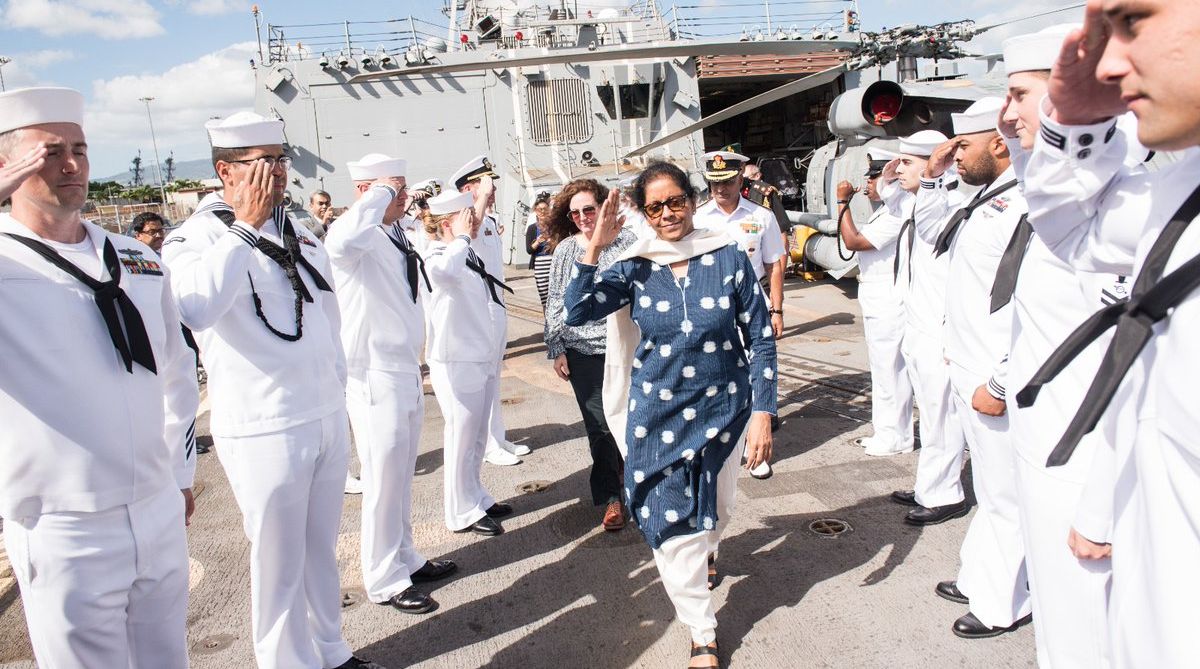Lok Sabha Election 2024, Phase 1: Voting on 102 seats underway
In the first phase of Lok Sabha elections 2024, as many as 102 constituencies spanning across 21 states and Union Territories will elect their new MPs.
There is a ‘mutual desire to move positively and quickly’ in defence relationship, Nirmala Sitharaman told media persons at the Pentagon on Monday

Defence Minister Nirmala Sitharaman's visit to the US Guided Missile Destroyer USS Michael Murphy on 6 December 2018 at Joint Base Pearl Harbour Hickam, Hawaii. (Photo: Twitter | @IndianEmbassyUS)
Defence Minister Nirmala Sitharaman Friday concluded her five-day visit to the United States, which officials said was aimed at “accelerating the momentum” of India-US defence ties — from enhancing India’s naval capabilities in the Indian Ocean region, to increasing the footprint of American companies in Make in India programme, and substantially increasing bilateral defence trade.
While no announcements were made with regard to shifting of F-16 production base to India or deals in armed drones, officials privy to the high-level talks said US is leaning way forward in meeting India’s needs and aspirations in the defence sector and is taking steps that would help it achieve its strategic goals.
There is a “mutual desire to move positively and quickly” in defence relationship, Sitharaman told media persons at the Pentagon on Monday, which was also her only media interaction during this US visit.
Advertisement
In the last one month, Prime Minister Narendra Modi first met Vice President Mike Pence and then was in a tri-lateral meeting involving US President Donald Trump and Japanese Prime Minister Shinjo Abe, wherein Indo-Pacific and regional peace was a discussed. Early this summer Mattis met Modi.
Sitharaman, the first woman defence minister of India, was accorded a red-carpet welcome during her maiden visit to the US in this capacity wherein she was given a rare look-in and briefing into the various aspects of US armed forces, defence industry and the ecosystem that the United States has developed over the last few decades involving the military, strategic thinking community, research and industrial base.
In San Francisco the hub of innovation and starts ups Sitharaman and her delegation was given an insight into the American defence research set up and what are the best defence practices that can be adopted by India.
Sitharaman capped off her trip with a visit to Hawaii the headquarters of the what early this year was rechristened as US Indo-Pacific Command.
This was but natural in a year when the United States started calling Asia Pacific as Indo-Pacific and renamed Pacific Command as Indo-Pacific Command or INDOPACOM.
“Our two democratic nations are committed to upholding a rules-based international order, which has brought decades of peace, stability, and prosperity. We are global partners on defence and security and this exemplifies our mutual cooperation to assure a free and open Indo-Pacific, said US INDOPACOM Commander Adm Phil Davidson.
The current situation in Indo-Pacific region was the topic of focus during Sitharaman’s meetings with US leaders, besides which a wide range of issues were covered, including situation in Afghanistan, Pakistan, recent developments in Sri Lanka, Maldives and quick co-ordination between the two powerful armies for peace purposes.
Issues like CAATSA and purchase of major defence equipment from Russia including S-400 did crop up during the meeting, but the Americans gave an impression that the Trump Administration is “eager than ever” to enhance its defence trade and strategic ties with India.
While making it clear that India can buy weapons from any country it sees fit, the American leadership suggested the Asian nation to select the US over other countries.
Some of the existing rules, regulations and legislations have slowed the process of defense acquisition from the US, the Indian delegation pointed out.
This was said despite major changes like India being accorded a ‘major defense partner’ status in 2016, India being placed in STA-1 category this year and the sub-continent nation signing the Communications Compatibility and Security Agreement in September.
Given India’s geographical location, its representatives said they were willing to place orders for latest military hardware and technology and not for anything else.
Further, the officials said India does not want simple defense trade as co-development and co-production need to be essential in the India-US defense relationship, they pointed out.
The Americans appeared on the same page, but expressed their sense of frustration over India’s defence procurement process.
At the conclusion of Sitharaman’s visit, in a statement, US INDOPACOM said this partnership was a reflection of the increasing strategic importance of the US-India security relationship and the progress both countries have made in advancing their defence cooperation.
The scope for mutual coordination and collaboration in the Indo-Pacific region continues to grow. Air forces of India and the US are currently conducting a 12-day military exercise in Kalaikunda and Panagarh air bases in West Bengal, with an aim to enhance operational coordination, according to India Air Forces officials. The ‘Ex Cope India-18’ will be the fourth edition in the series of bilateral drills between the Indian Air Force and the US Air Force.
Meeting her American counterpart at the Pentagon on Monday, Sitharaman had said the recent high-level meetings are an indication of the depth and quality of “our bilateral partnership, as well as our mutual desire” to work closely on a range of bilateral and global issues.
Sitharaman described her US visit as part of her endeavour to “take forward bilateral defence cooperation”.
Noting that the India-US relationship in defence has acquired the dimensions of a strategic partnership over the last decade, she said the two countries have made considerable progress.
Advertisement